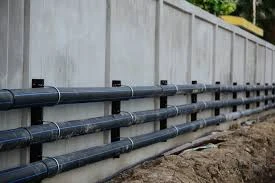Nov . 05, 2024 20:20 Back to list
plastic welding rod
The Importance of Plastic Welding Rods in Modern Fabrication
Plastic welding rods are essential tools in the realm of plastic fabrication and repair. As industries increasingly lean on synthetic materials for their lightweight, durability, and corrosion resistance, understanding the application and significance of plastic welding rods has become paramount for manufacturers and craftspeople alike.
Plastic welding, much like traditional metal welding, involves the joining of two or more pieces of material through the application of heat. This process can create strong bonds that return the material to its integral form. The use of specialized welding rods tailored to the specific type of plastic is crucial to achieving the best results. These rods come in various compositions, typically designed to match the melting point and properties of the parent plastic, ensuring compatibility and effectiveness during the welding process.
Types of Plastic Welding Rods
There are several types of plastic welding rods, each suited for different applications. For instance, polyethylene (PE) rods are widely used due to their excellent chemical resistance and flexibility. They are particularly favored in the fabrication of tanks and containers. Similarly, polypropylene (PP) rods, known for their strength and stiffness, see extensive use in automotive components and industrial applications.
Moreover, there are specialty rods, such as acrylonitrile butadiene styrene (ABS) rods, which are favored for their impact resistance and toughness. ABS is commonly found in consumer products, from automotive parts to household appliances. Choosing the right rod is crucial not just for ensuring a strong weld but also for maintaining the integrity and properties of the assembled product.
The Welding Process
The process of using plastic welding rods involves heating the area to be joined and the rod itself until they reach their melting points. This is typically achieved through various welding techniques such as hot air welding, extrusion welding, or through the use of welding machines designed specifically for plastics. The molten state allows the rod to flow into the joint, which, upon cooling, solidifies to create a robust bond.
plastic welding rod

Expertise in the welding process is essential, as improper temperature or technique can lead to defects such as warping, insufficient bonding, or contamination of the weld site. Thus, training and experience are important factors for technicians and workers involved in plastic welding.
Applications of Plastic Welding Rods
The applications for plastic welding rods are vast and varied. In construction, they are used in the assembly of plastic piping systems, ensuring leak-proof joints that withstand high pressures. In the automotive industry, welded plastic components contribute to the overall safety and efficiency of vehicles, including bumpers, dashboards, and fuel tanks.
Furthermore, plastic welding rods are employed in the fabrication and repair of various consumer goods such as toys, household items, and electronic casings. The ability to repair rather than replace damaged plastic components provides both economic and environmental benefits, as it reduces waste and extends product life cycles.
The Environmental Aspect
As sustainability becomes a significant focus across industries, the role of plastic welding rods can not be understated. By facilitating the repair of plastic items, these rods help in minimizing the environmental impact of plastic waste. In a world where plastic pollution is a growing concern, the ability to extend the life of plastic products through effective welding techniques offers a viable solution to reduce waste.
Conclusion
Plastic welding rods are not just simple tools; they are vital components in modern manufacturing and repair processes. Their diverse types cater to various plastics used in numerous industries, ensuring that the integrity and performance of products are upheld. With an increasing focus on sustainability, plastic welding rods present a solution to reduce waste and promote responsible usage of synthetic materials. As technology advances, the methods and materials associated with plastic welding will continue to evolve, opening up new possibilities for efficiency and sustainability in manufacturing.
-
High-Quality PPR Pipes and Fittings Durable ERA PPR & PVC PPR Solutions
NewsJul.08,2025
-
Black HDPE Cutting Board - Durable, Non-Porous & Food Safe HDPE Plastic Cutting Board
NewsJul.08,2025
-
High-Quality CPVC Panel Durable HDPE & PVC Panels Supplier
NewsJul.08,2025
-
Double PE Welding Rod Supplier - High Strength, Durable & Versatile Welding Solutions
NewsJul.07,2025
-
High-Quality PVC-O Pipe Supplier Durable 75mm PVC Pipe & Connections Leading PVC Pipe Company
NewsJul.07,2025
-
HDPE Drainage Pipe Supplier – Durable & Corrosion-Resistant Solutions
NewsJul.06,2025

